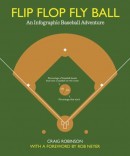 Today is a good day for baseball geeks like me, as it marks the publication of Craig Robinson’s Flip Flop Fly Ball
Today is a good day for baseball geeks like me, as it marks the publication of Craig Robinson’s Flip Flop Fly Ball, an oversize, lavishly illustrated book based on Robinson’s blog of infographics. The combination of his precisely created charts and the offbeat things they chart reflects a brain firmly, winningly divided between the game’s childlike, imaginative pull and the over-thought technocracy of its sabermetrics era.
An excerpt from the book’s introduction in which Robinson recites some of the questions that fuel his work gives a good sense of just how bizarre, playful, and addictive the book is:
“What distance is covered by base runners in a season? How big is the Green Monster compared to the Statue of Liberty? Which player has played for the most organizations? How many teams have their home dugout on the first-base side? How many Native Americans live in Cleveland? . . . Who was the last player called Wright to play in right field? (It was George Wright for the Expos in 1986. And, incidentally, no player called Short has ever played shortstop.) Which team’s players travel the greatest distance from rookie ball to single-A, double-A, triple-A, and then the majors? Has any player ever played in all the towns Steve Miller mentions in “Rock’n Me”? What was number one on the Billboard Hot 100 when Nolan Ryan made his debut and when he played his last game?* Which town in the contiguous United States is the farthest from a major league team?
Many of the charts and graphs in the book are new, but a few are available for viewing on the blog, like how far off Earth’s surface A-Rod’s annual salary would reach if it were a stack of pennies. This is hardly the strangest thought that has passed through Robinson’s brain. How about breaking down bobblehead giveaways? Or compiling the directional orientation of batters at each big-league stadium? But along with these more comic offerings are more straightforward historical interests, like a time line of all the teams that have played in the American or National leagues, or a map showing all the times a team has relocated.
The oddest thing about Robinson might be that he is an Englishman who didn’t really discover baseball until his mid-thirties. But when you read a few of the essays sprinkled throughout the book — about how he came to the sport and fell in love with “the evil team,” the Yankees; about a road trip to stadiums around the country; about his irrational affection for the Colorado Rockies — it’s hard to imagine he didn’t grow up somewhere in America, kicking around a Little League field and dreaming of distant minor league ballparks.
*”You Can’t Hurry Love” by the Supremes and “Dreamlover” by Mariah Carey, respectively.

